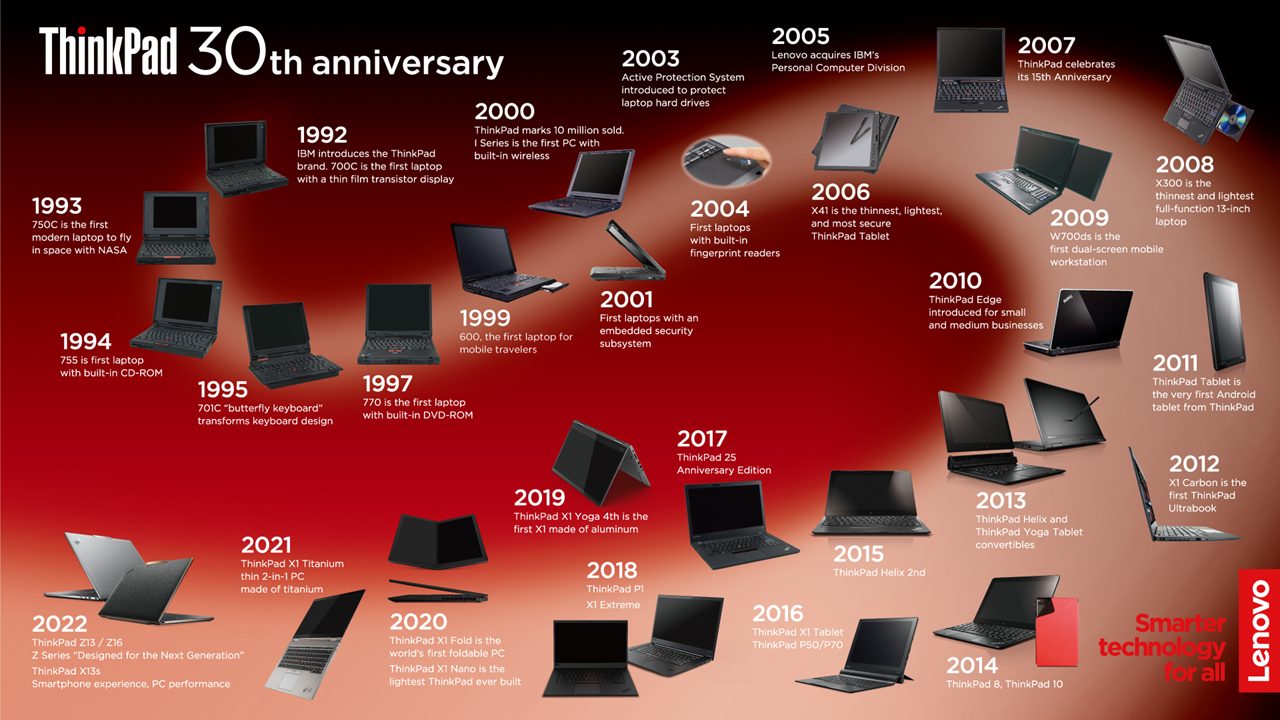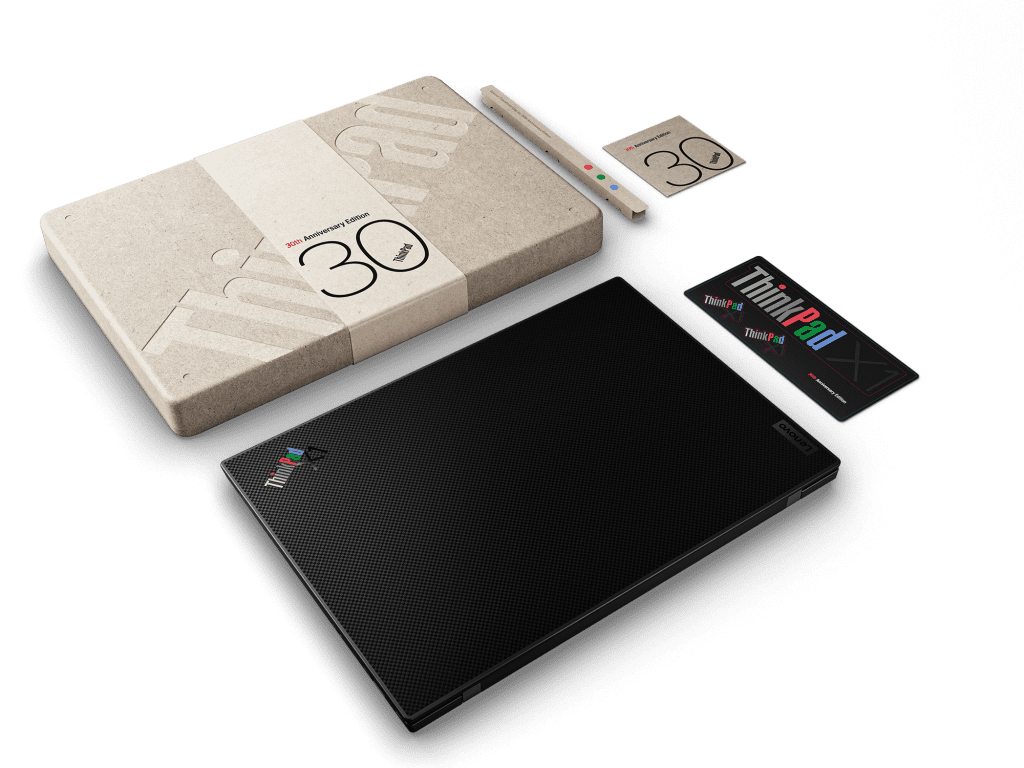Many pages of virtual ink, and indeed actual ink have been penned over the past 30 years about ThinkPad and how this icon of the IT industry that has continuously powered businesses, supported space missions and explored all four corners of Earth.
As we celebrate 30 years of history and 200 million units sold, the time is now to look ahead and imagine how the future of ThinkPad will look. However, before we speculate, I feel it’s important to establish what ThinkPad is, and what it stands for.
A Family Creates an Icon
Everyone involved in the design and engineering of the first ThinkPad 700C believed they were on to something special, but never in their wildest dreams could they have foreseen the extraordinary impact and success that the brand witnessed. That success however is a result of a tight knit community involving the designers and engineers, the partners and suppliers, and the customers and fans who have all continued to show utmost devotion in our quest to persistently reimagine mobile computing.
That family of industry leading experts remain laser focused on the development of ThinkPad for today, and tomorrow. As David Hill, our former Chief Design Office, said five years ago, “ThinkPad design creates a powerful and synergistic relationship between form and function. It balances sophisticated aesthetics, thoughtfully crafted user experiences and renowned engineering in order to deliver superior products.” This is the DNA that all involved adhere to. Designed and engineered to be instantly recognizable and to deliver the kind of user experience that people depend on. Whichever model you have, it will do what you need it to do, when you need it, and where you need it, without fuss or fanfare.
Always Dependable, but We Know Innovation
Before I wonder on the future, I want to touch on a subject that admittedly is all about personal perception, but one that I feel strongly about. “ThinkPad is boring.” I prefer to look at ThinkPad as a successful design that stands the test of time, like a Porsche 911 or a Harley Davidson. There is a ThinkPad on display at MoMA in New York, the only laptop permanently displayed in an art museum.
I suggested at the beginning that I wouldn’t go down memory lane, but I need to make a point. Here are a few choice firsts that clearly identify that ThinkPad has repeatedly pushed the boundaries of what is possible, and could never be classed as “boring”:
- First laptop with color TFT display
- First with built-in CD-ROM
- First with built-in DVD-ROM
- First with integrated Wi-Fi
- First with hardware embedded security and fingerprint reader
- First dual-screen mobile workstation
- World’s lightest full-function 13-inch laptop
- World’s lightest full-function 14-inch laptop!
- World’s first foldable PC
 ThinkPad isn’t about fanfare, ThinkPad exists to achieve a purpose or rather to help users achieve a purpose and these significant milestones were not just because we could do it, but because they all addressed a particular user challenge or opened up new ways or working.
ThinkPad isn’t about fanfare, ThinkPad exists to achieve a purpose or rather to help users achieve a purpose and these significant milestones were not just because we could do it, but because they all addressed a particular user challenge or opened up new ways or working.
Looking to the Immediate Future
Speculation is always fraught with danger. Making long term predictions can come back to haunt, and has done so many times that I shall not highlight here. But we are in an industry driven by innovation and we have a duty to guide and influence the paths the industry follows in order to help build a better future.
One speculation I can absolutely 100% confirm is that we have launched a special, very limited edition of our amazing ThinkPad X1 Carbon Gen 10.

ThinkPad X1 Carbon 30th Anniversary Edition is available to order on Lenovo.com in select countries with only 5000 units around the world and 1000 units for Japan, the birthplace of ThinkPad. The numbered units will include a woven carbon fiber top cover with special retro logo that also features below the keyboard. It also includes special silk print 30th Anniversary Edition lettering and recycled and recyclable packaging, special edition stickers, retro TrackPoint caps and a collector’s booklet.
This special model is available today, but what will tomorrow bring? Before we can truly address the technology, we need to think about the needs. We’ve already experienced a changing world over the past 30 years, and none more so than the past two years. Add to that new tech-aware generations entering the workplace with different requirements and expectations. We also have moral obligations to seek to address global societal issues such as sustainability, diversity and inclusion, and social governance. These are all current concerns that must not be overlooked; however the long-term objective is to innovate so these issues are addressed at a foundational level, not as an afterthought.
The Crystal Ball of Tomorrow’s Tech
When we dig deeper into technological breakthroughs, we can probably over-simplify by breaking them down into three categories: Displays, Power, and Interface.
I’m not going to get into deep levels of detail and there are of course many other areas of innovation, but I’d rather focus on a few and suggest areas of thought. As I mentioned speculation can be dangerous, so I’m not making predictions here. I don’t want someone coming up to me in twenty years saying, “remember what you said back then”!
Displays are our primary way of consuming information. Until recently, mostly flat of varying sizes. Now we have foldable displays. We also have rollable and slidable. They all have a future, and their development will depend on the user experience. I’ve said before, competition is healthy because it can only benefit the end user through technology improvement and economies of scale that make trail-blazing innovation more accessible. Foldable technology will allow us to research new form factors and incorporate different use cases. But what about longer term future? Virtual displays, those delivered through glasses are most likely to establish themselves in various functions combined with other intelligence driven technology. Think metaverse, but also healthcare, finance and even becoming more prominent in education. Other display technologies such as holographic may be on the horizon, but I suspect that widespread commercialization in PC’s is many years away.
Power is the holy grail! By this, I don’t mean performance, we’ll have that in spades, I mean battery. What is the next tipping point in battery technology? Today and for the immediate future we will be focused on efficiency. Maximizing the efficiency of the power we have, but at some point, new ways of delivering power will arise and probably in ways we haven’t yet thought of. We can just about squeeze 24-hours from a small selection of laptops, but multi-day or even a week without plugging in is where everyone in the tech industry would like to be. Even suggesting what that technology may be would be futile, however the concept of a fully electric car 30 years ago was a pipedream, so who knows.
The interface we are used to has certainly evolved over the past 30 years, but like ThinkPad it remains instantly recognizable. There is reason for that. Humans have particular senses that interact in a limited number of ways with technology. Sight, touch and sound. We see a display, we type on a keyboard or touch a screen, and we hear sounds that can mean specific things. I’ve not come across taste sense yet in PC technology, but happy for anyone to prove me wrong!
Evolution will continue, but how do we revolutionize the interface or rather our interaction with PC technology. In some ways, it has already begun through voice activation in smart home devices but it remains relatively limited in function. But the fundamentals are there to make the leap from occasional use to total voice interaction with your PC. This may continue to have limitations however in public or office spaces. Imagine several hundred people in an open office all talking to their PCs! Virtual interaction may be something to look out for. As mentioned early, smart glasses are starting to mature and the possibility of “seeing” a 3D projection of multiple windows from your laptop that you can interact with through gestures is quite compelling, but I’d still rather type this post on a good old keyboard than be making wild typing gestures for ten words per minute in a busy internet café! Thought interaction could be the answer, but now we’re talking science fiction. Or are we? Well, I’m not going to speculate on that, and to be clear we do not have a thought interactive laptop waiting in the wings!
Happy Birthday ThinkPad Team!
As I come to the end, I just wanted to share this milestone and provide some food for thought and hopefully generate some interesting coffee shop discussions.
Finally, I want to wish everyone involved with ThinkPad a happy birthday. If you have ever been involved in designing, engineering, supplying, manufacturing, shipping or just owning a ThinkPad. Thank you. You all share the passion that has made 30 years memorable and will make the next 30 years unforgettable.
